PHOENIX — The key to slowing the spread of COVID-19 in Arizona could be finding a way to reach the people who believe they’re the least likely to get infected or suffer ill effects, the state’s top health official says.
Dr. Cara Christ said the biggest group of positive test results is now among those 20 through 44 years old.
“They’re likely not the ones that are going to have the outcomes and the risk factors from COVID-19,” she told Capitol Media Services. “But we need everybody to keep in mind that all of us have connections to loved ones and family members that are high risk or people out in the community,” Christ said.
“And that’s what we’re trying to protect by containing the spread.”
The trick now, Christ said, is crafting a message that is designed with that audience in mind.
“We do want to see these numbers come down and we want to see the percent positivity go down,” Christ said.
That, however, means convincing individuals to act safely — including those who may believe that even if they don’t think they’re invincible that contracting the virus won’t really hurt them.
And that, Christ said, comes back to the messages of physically distancing and wearing a mask while out in public when staying 6 feet from others is impossible.
That message, however, is not getting across to those in the 20- to 44-year-old demographic, she said, as evidenced by the high number of people in that age group who are testing positive for the virus — and as shown by videos of people crowding Arizona bars without masks.
These are the people who are less likely to suffer severe adverse effects. But they’re clearly coming down with — and probably transmitting — the disease.
Consider: Of more than 43,000 confirmed cases of COVID-19 so far, more than 46% fall into that age group.
But they make up less than a third of the population.
Yet they’re not dying at the same rate of the disease, accounting for just 67 of the more than 1,300 deaths.
Christ said exhortations for these people to protect themselves apparently does not work. So that, she said, requires a change in the message.
“We need everyone to think about, ‘You may not feel sick, you may not think that you’ve been infected,’” Christ said. And a lot of people appear asymptomatic.
“So it’s really important that if you are going to be within 6 feet of somebody you have got to wear that mask,” she said.
Christ said it may not be that younger people see themselves as invincible.
“I think a pandemic and a virus, they’re scary things, they’re hard to comprehend,” she said. “And I think if you are not seeing the direct outcomes, you may not think that it applies.”
Christ said her agency had the same problem crafting a message during the opioid epidemic of trying to reach those who didn’t see it as their issue.
In that case, she said, the health department crafted some very scary messages — scary enough so that her son, 8 at the time, came crying to her after seeing some on social media.
“It gave me that opportunity to talk with him about the dangers of opioids.” Christ said. “And so, it worked.”
But finding a message that resonates when warning people about a virus, she said, is something quite different. And that may be telling people they need to think about more than how the pandemic affects them personally.
“A lot of them have grandparents and loved ones that they love and don’t want to see anything happen to,” Christ said, sending a message that “this is really, really dangerous for those you love and so we need to do everything we can to protect them.”
It’s not just that category of 20- to 44-year-olds with a sense that they’re not affected that is complicating efforts by the state to curb the spread of COVID-19. The problem, according to Gov. Doug Ducey, extends to those even younger.
The governor said that, for a long time, he didn’t personally know anyone who had the virus.
“But just recently, I know a lot of people that have contracted this,” he said. “And I want to tell you where they contracted this: at graduation parties, at private gatherings in homes.”
Christ said reaching this group isn’t a simple matter of telling them that, while they won’t get sick, they can bring the disease home to others.
“That’s not going to work with them,” she said.
One thing she said her agency has learned is that, when dealing with teens, it’s probably best that the message isn’t coming from the government.
“It probably should come from a trusted source for that group,” Christ said.
At the very least, that means using different media.
“They’re not going to watch the news,” she said. “They’re not going to be on the same social media sites that their parents are.”
And then the message itself needs to be different for teens than it is for adults.
“For instance, when you’re looking at vaping, what resonated with the kids was, ‘Don’t lie to me, don’t tell me this is safe when it’s actually not,’” Christ said.
“You’ve got to find what resonates with them,” Christ said.
Photos for May 29: Tucson gets by during Coronavirus Pandemic
Tucson gets by during coronavirus pandemic
Updated
The iconic Casa Molina bull and matador statue both sport masks on the first full week of the loosening of COVID19 restrictions, May 23, 2020, Tucson, Ariz. The bull previously had a mask on the testicles.
Tucson gets by during coronavirus pandemic
Updated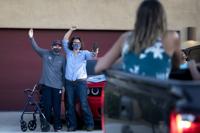
Michelle Leon Cordova, right, mother, and her son Sahuarita High School senior Lino Cordova, whom is fighting cancer, wave at staff members from Diamonds Children Center, friends and the Marana Police Department during a car parade, celebrating Lino's graduation, outside of his home on May 13, 2020 in Sahuarita, Ariz. Cordova stood on the sidewalk while the team from Diamond Children Center, friends and the Marana police department gave Cordova a graduation gar parade. Cordova was given a gift basket with his favorite snacks, gift cards as well as other items he enjoys. The car parade, also, celebrated another graduating senior fighting cancer from Empire High School, Noah Nieto. Nieto, also, received a gift basket with snacks, gift cards and other items Lino enjoys.
Tucson gets by during coronavirus pandemic
Updated
Michelle Leon Cordova, right, mother, brings celebration balloons to a car after staff members from Diamonds Children Center, friends and the Marana Police Department celebrate Sahuarita High School senior Lino Cordova, whom is fighting cancer, graduation with a car parade outside of his home on May 13, 2020 in Sahuarita, Ariz. Cordova stood on the sidewalk while the team from Diamond Children Center, friends and the Marana police department gave Cordova a graduation gar parade. Cordova was given a gift basket with his favorite snacks, gift cards as well as other items he enjoys. The car parade, also, celebrated another graduating senior fighting cancer from Empire High School, Noah Nieto. Nieto, also, received a gift basket with snacks, gift cards and other items Lino enjoys.
Tucson gets by during coronavirus pandemic
Updated
Personnel from Tucson Medical Center line the heliport to watch A-10's from Davis-Monthan Air Force Base's 355th Wing and F-16's from the Arizona Air National Guard's 162nd Wing make a pass over the facility, one leg of an area wide community flyover, May 14, 2020, Tucson, Ariz.
Tucson gets by during coronavirus pandemic
Updated
Nancy Celix-Campos, right, a respitory therapist at Tucson Medical Center, watches the military flyover with her daughters, Giana, 12, and Jazmyn, 8, from Sentinel Peak on May 14, 2020. Two F-16 Fighting Falcons from Arizona Air National GuardÕs 162nd Wing and two A-10 Thunderbolt II's from the 355th Wing, assigned to Davis-Monthan Air Force Base, fly over Tucson area hospitals to honor healthcare personnel and first responders as they are some of the frontline workers dealing with the coronavirus disease (COVID-19) head on. "It's been an exhausting two to three months," says Campos, "it's pretty cool, I like how they're going by each hospital."
Tucson gets by during coronavirus pandemic
Updated
Two F-16 Fighting Falcons from Arizona Air National Guard’s 162nd Wing and two A-10 Thunderbolt II's from the 355th Wing, assigned to Davis-Monthan Air Force Base, fly over Northwest Medical Center north of Tucson on May 14, 2020.
Tucson gets by during coronavirus pandemic
Updated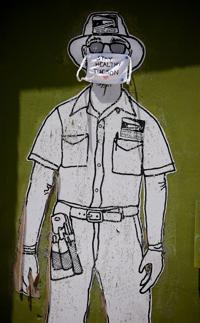
A letter carrier portrait on the Ok Market building, located in the Armory Park neighborhood, is adorned with a face mask on May 18, 2020.
Tucson gets by during coronavirus pandemic
Updated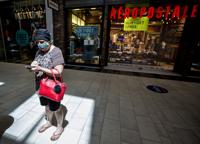
Rosemary Garcia waits for a family member outside of a store at Park Place Mall, 5870 E. Broadway Blvd., in Tucson, Ariz. on May 19, 2020. Malls reopened today under CDC guidelines and Gov. Ducey's new rules for businesses due to the Coronavirus pandemic. Park Place Mall has signs throughout the mall reminding customers to keep a six feet distance as well as hand sanitizer stations near each entrance. About half of the tables in the food court have been removed to allow for social distances as well as less than half of the stores have opened with new guidelines. Of the stores open, only 10 customers are allowed to shop in each store at a time.
Tucson gets by during coronavirus pandemic
Updated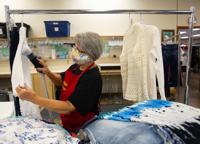
Pat Schlote steams clothing before it is put on the sales floor at the Golden Goose Thrift Shop in Catalina, Ariz., on May 21, 2020.
Tucson gets by during coronavirus pandemic
Updated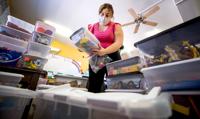
Ada Contreras, teaching assistant, looks through containers while reorganizing toys at Herencia Guadalupana Lab School, 6740 S. in Tucson, Ariz. on May 21, 2020. As Child care centers begin to re-open when they are ready, Herencia Guadalupana Lab School is reorganizing and cleaning everything in the facility before re-opening on June 2. To allow for social distancing and decrease the amount of items children touch, Herencia Guadalupana Lab School has sheds where items will go as well as placing items in containers organized by category.
Tucson gets by during coronavirus pandemic
Updated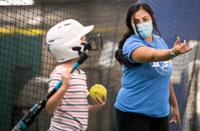
Jen Martinez, right, softball coach, teaches Skylar Reilly about hitting during a session at Centerfield Baseball Academy, 5120 S. Julian Dr., in Tucson, Ariz. on May 21, 2020. After re-opening on Monday, Centerfield Baseball Academy has implemented new policies in response to the Coronavirus Pandemic such as wearing masks, cleaning, signage, hand sanitizer and limiting the amount of people inside the facility.
Tucson gets by during coronavirus pandemic
Updated
Karl Bosma, left, and George Cantua, with facilities and maintenance, lay down stickers to mark six-foot separation distance around one of the baggage carousels, part of the efforts at Tucson International Airport to work within the restrictions of COVID19, May 22, 2020, Tucson, Ariz.
Tucson gets by during coronavirus pandemic
Updated
A lone passenger waits for a flight near one of the shuttered restaurants in the B Gates before Memorial Day at Tucson International Airport on May 22, 2020.
Tucson gets by during coronavirus pandemic
Updated
Drew Cooper on the stage in the St. Philip's Plaza courtyard, May 22, 2020, Tucson, Ariz., where live music is back on the schedule.
Tucson gets by during coronavirus pandemic
Updated
Many people visit Tumamoc Hill during the first day of Tumamoc's re-opening in Tucson, Ariz. on May 25, 2020. After being closed due to the Coronavirus pandemic, Tumamoc Hill re-opened with some modifications. There are hand sanitizer stations throughout the hike to the top as well as arrows, spaced 10-ft apart, lined up and down the hill. Some runners, hikers and walkers are also wearing masks during their hike. "The steps we are taking aim to provide our community with needed exercise, connection to our beautiful desert and a sense of comfort in such a trying time, while balancing the fact that gathering as a community endangers each of us and our loved ones. This is an unprecedented challenge that we are taking extremely seriously," said Benjamin T. Wilder, director of Tumamoc Hill. Visitors are also asked to limit their group to three people and to not touch the gate at the top of the hill- a tradition for some who make it to the top. "This is a time when we need to establish new traditions and adapt in a creative manner that embraces empathy, unity, care and patience," Wilder said.
Tucson gets by during coronavirus pandemic
Updated
Pen Macias, artist, works on part 2 of a mural for a client on E. Broadway Rd., between S. Columbus Blvd. and S. Alvernon Way, in Tucson, Ariz. on May 25, 2020. Macias, known as The Desert Pen, has been working on her clients mural for the past three months. "It's the one thing I love, I have a passion for and the only thing I could be happy doing," said Macias. The mural represents her client, a single mother of four who works in the health care field. One half of the mural is dedicated to the connection between mothers and their children. The other half is dedicated to the connection between nurses and patients. The client wanted some positivity in the mural to show how nurses give a piece of themselves to their patients hence the puzzle pieces in the nurse and the patients, said Macias.
Tucson gets by during coronavirus pandemic
Updated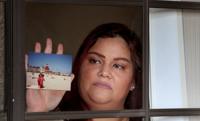
Christina Cortinas, posing at her home, May 28, 2020, Tucson, Ariz., with a photo of her and her mother, Catherine Rodriguez, in San Diego, 1991. Rodriguez is currently in assisted living and fighting COVID19. Cortinas hasn't seen her mother in months, the longest such span in her life.
Tucson gets by during coronavirus pandemic
Updated
Ruben Lopez looks through handouts while attending a Eviction Resource Fair with his family outside the Pima County Justice Court.



